First Semester LLW3008 Equity and Trusts Essay: Action vs. Remedy
VerifiedAdded on 2023/01/17
|8
|2283
|387
Essay
AI Summary
This essay critically examines the statement that at common law, the cause of action is identified before the remedy, while in equity, it's the reverse. It traces the historical development of equity, highlighting its origins in response to the limitations of the common law writ system. The essay explores the key differences between the two legal systems, including remedies, the role of the Chancellor, and the impact of the Judicature Acts. It discusses equitable remedies like injunctions and specific performance, contrasting them with common law damages. The analysis covers the concept of trusts, the distinction between rights in rem and in personam, and the ongoing relationship between equity and common law, emphasizing their balance and the influence of precedent. The essay concludes by asserting that equity complements the common law, providing supplementary rules and remedies to achieve justice and fairness, while acknowledging the similarities and differences between them.

At Common Law the cause of action is identified then the remedy. In Equity it is the reverse.
Do you agree? Critically discuss the statement
It can be stated in this regard that the birth of equity took place when the strictures of the writ
system failed to develop further remedies during the 12th and 13th centuries. Under these
circumstances, the disappointed litigants started to get petitions to the king for doing justice in
their particular cases, because the king was considered as the "fountain of all justice". However,
with the rise in the number of these petitions, the King passed on this responsibility to the
Chancellor, who was the senior most officer of the King and was considered as the "keeper of
the conscience of the King". When these traditions were received by the Chancellor, the
chancellor adjudicated and relied upon the principles of justice and fairness. In this way, the
words of equity took place.
By the 15th century, equity was well recognized and it was going to be considered as a viable
system of common law. The jurisdiction of the Chancellor was implemented by the Court of
Chancery. It needs to be noted that it was not assured by the precedent or the firm lawful rules
that were applicable in case of the common law courts. The result was that he was in a position
to use his discretion for administering justice according to the particular requirements of the
case. Similarly, well-established principles were also developed by them which administer the
application of pleasure of the court. These rules were adjustable and bendable and assisted the
Court in attaining impartiality and fairness. It had been stated in Wilson v Northampton and
Do you agree? Critically discuss the statement
It can be stated in this regard that the birth of equity took place when the strictures of the writ
system failed to develop further remedies during the 12th and 13th centuries. Under these
circumstances, the disappointed litigants started to get petitions to the king for doing justice in
their particular cases, because the king was considered as the "fountain of all justice". However,
with the rise in the number of these petitions, the King passed on this responsibility to the
Chancellor, who was the senior most officer of the King and was considered as the "keeper of
the conscience of the King". When these traditions were received by the Chancellor, the
chancellor adjudicated and relied upon the principles of justice and fairness. In this way, the
words of equity took place.
By the 15th century, equity was well recognized and it was going to be considered as a viable
system of common law. The jurisdiction of the Chancellor was implemented by the Court of
Chancery. It needs to be noted that it was not assured by the precedent or the firm lawful rules
that were applicable in case of the common law courts. The result was that he was in a position
to use his discretion for administering justice according to the particular requirements of the
case. Similarly, well-established principles were also developed by them which administer the
application of pleasure of the court. These rules were adjustable and bendable and assisted the
Court in attaining impartiality and fairness. It had been stated in Wilson v Northampton and
Paraphrase This Document
Need a fresh take? Get an instant paraphrase of this document with our AI Paraphraser
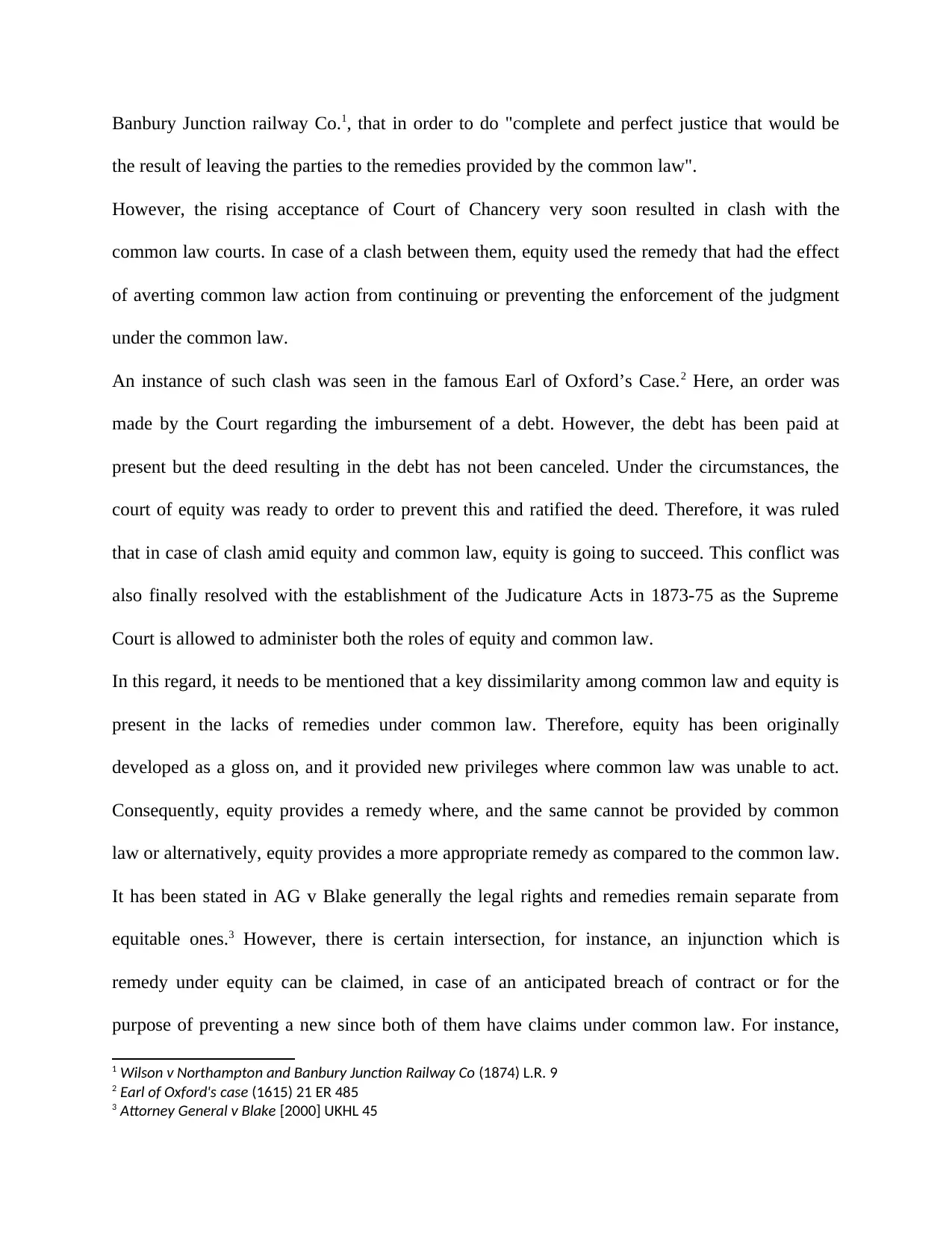
Banbury Junction railway Co.1, that in order to do "complete and perfect justice that would be
the result of leaving the parties to the remedies provided by the common law".
However, the rising acceptance of Court of Chancery very soon resulted in clash with the
common law courts. In case of a clash between them, equity used the remedy that had the effect
of averting common law action from continuing or preventing the enforcement of the judgment
under the common law.
An instance of such clash was seen in the famous Earl of Oxford’s Case.2 Here, an order was
made by the Court regarding the imbursement of a debt. However, the debt has been paid at
present but the deed resulting in the debt has not been canceled. Under the circumstances, the
court of equity was ready to order to prevent this and ratified the deed. Therefore, it was ruled
that in case of clash amid equity and common law, equity is going to succeed. This conflict was
also finally resolved with the establishment of the Judicature Acts in 1873-75 as the Supreme
Court is allowed to administer both the roles of equity and common law.
In this regard, it needs to be mentioned that a key dissimilarity among common law and equity is
present in the lacks of remedies under common law. Therefore, equity has been originally
developed as a gloss on, and it provided new privileges where common law was unable to act.
Consequently, equity provides a remedy where, and the same cannot be provided by common
law or alternatively, equity provides a more appropriate remedy as compared to the common law.
It has been stated in AG v Blake generally the legal rights and remedies remain separate from
equitable ones.3 However, there is certain intersection, for instance, an injunction which is
remedy under equity can be claimed, in case of an anticipated breach of contract or for the
purpose of preventing a new since both of them have claims under common law. For instance,
1 Wilson v Northampton and Banbury Junction Railway Co (1874) L.R. 9
2 Earl of Oxford's case (1615) 21 ER 485
3 Attorney General v Blake [2000] UKHL 45
the result of leaving the parties to the remedies provided by the common law".
However, the rising acceptance of Court of Chancery very soon resulted in clash with the
common law courts. In case of a clash between them, equity used the remedy that had the effect
of averting common law action from continuing or preventing the enforcement of the judgment
under the common law.
An instance of such clash was seen in the famous Earl of Oxford’s Case.2 Here, an order was
made by the Court regarding the imbursement of a debt. However, the debt has been paid at
present but the deed resulting in the debt has not been canceled. Under the circumstances, the
court of equity was ready to order to prevent this and ratified the deed. Therefore, it was ruled
that in case of clash amid equity and common law, equity is going to succeed. This conflict was
also finally resolved with the establishment of the Judicature Acts in 1873-75 as the Supreme
Court is allowed to administer both the roles of equity and common law.
In this regard, it needs to be mentioned that a key dissimilarity among common law and equity is
present in the lacks of remedies under common law. Therefore, equity has been originally
developed as a gloss on, and it provided new privileges where common law was unable to act.
Consequently, equity provides a remedy where, and the same cannot be provided by common
law or alternatively, equity provides a more appropriate remedy as compared to the common law.
It has been stated in AG v Blake generally the legal rights and remedies remain separate from
equitable ones.3 However, there is certain intersection, for instance, an injunction which is
remedy under equity can be claimed, in case of an anticipated breach of contract or for the
purpose of preventing a new since both of them have claims under common law. For instance,
1 Wilson v Northampton and Banbury Junction Railway Co (1874) L.R. 9
2 Earl of Oxford's case (1615) 21 ER 485
3 Attorney General v Blake [2000] UKHL 45
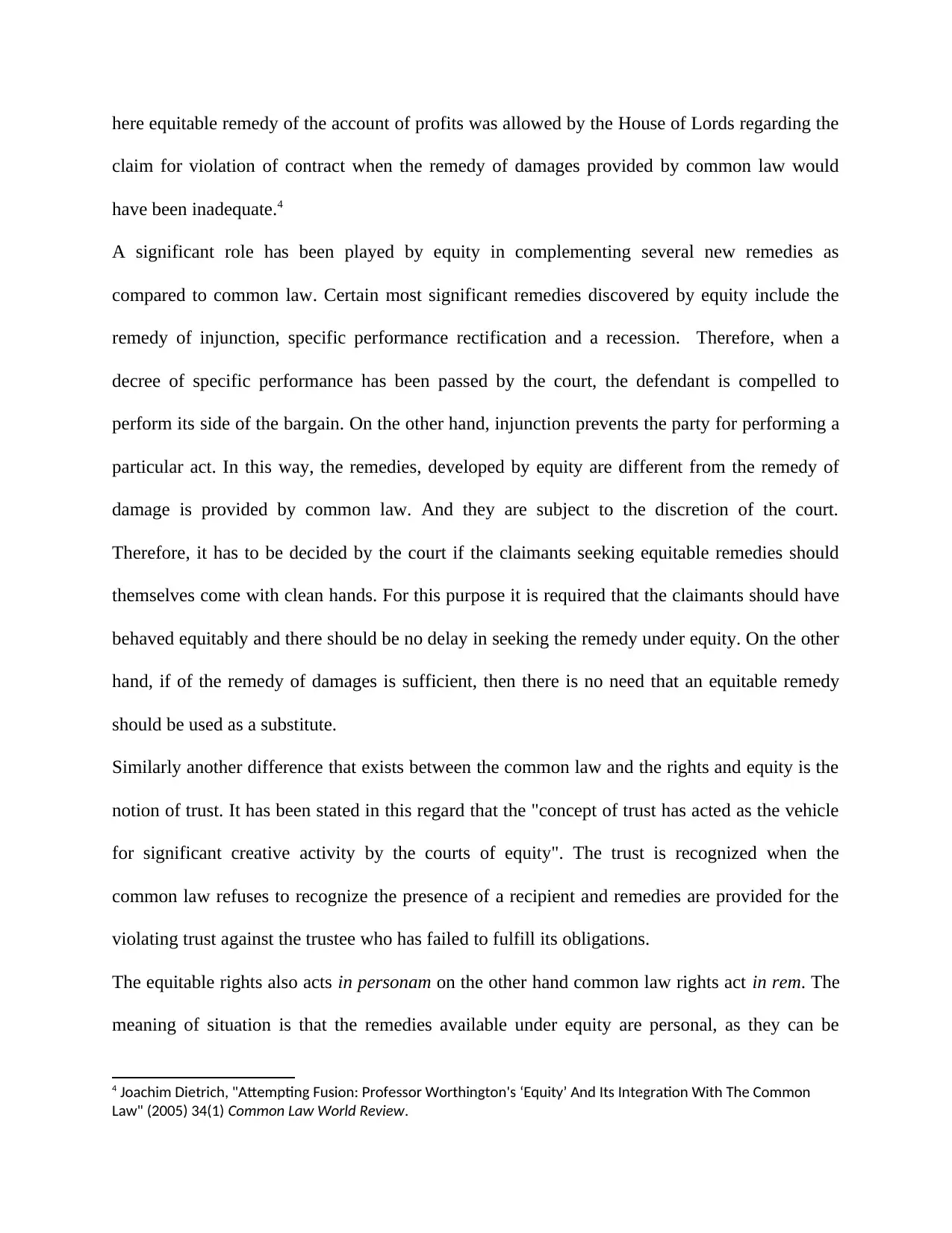
here equitable remedy of the account of profits was allowed by the House of Lords regarding the
claim for violation of contract when the remedy of damages provided by common law would
have been inadequate.4
A significant role has been played by equity in complementing several new remedies as
compared to common law. Certain most significant remedies discovered by equity include the
remedy of injunction, specific performance rectification and a recession. Therefore, when a
decree of specific performance has been passed by the court, the defendant is compelled to
perform its side of the bargain. On the other hand, injunction prevents the party for performing a
particular act. In this way, the remedies, developed by equity are different from the remedy of
damage is provided by common law. And they are subject to the discretion of the court.
Therefore, it has to be decided by the court if the claimants seeking equitable remedies should
themselves come with clean hands. For this purpose it is required that the claimants should have
behaved equitably and there should be no delay in seeking the remedy under equity. On the other
hand, if of the remedy of damages is sufficient, then there is no need that an equitable remedy
should be used as a substitute.
Similarly another difference that exists between the common law and the rights and equity is the
notion of trust. It has been stated in this regard that the "concept of trust has acted as the vehicle
for significant creative activity by the courts of equity". The trust is recognized when the
common law refuses to recognize the presence of a recipient and remedies are provided for the
violating trust against the trustee who has failed to fulfill its obligations.
The equitable rights also acts in personam on the other hand common law rights act in rem. The
meaning of situation is that the remedies available under equity are personal, as they can be
4 Joachim Dietrich, "Attempting Fusion: Professor Worthington's ‘Equity’ And Its Integration With The Common
Law" (2005) 34(1) Common Law World Review.
claim for violation of contract when the remedy of damages provided by common law would
have been inadequate.4
A significant role has been played by equity in complementing several new remedies as
compared to common law. Certain most significant remedies discovered by equity include the
remedy of injunction, specific performance rectification and a recession. Therefore, when a
decree of specific performance has been passed by the court, the defendant is compelled to
perform its side of the bargain. On the other hand, injunction prevents the party for performing a
particular act. In this way, the remedies, developed by equity are different from the remedy of
damage is provided by common law. And they are subject to the discretion of the court.
Therefore, it has to be decided by the court if the claimants seeking equitable remedies should
themselves come with clean hands. For this purpose it is required that the claimants should have
behaved equitably and there should be no delay in seeking the remedy under equity. On the other
hand, if of the remedy of damages is sufficient, then there is no need that an equitable remedy
should be used as a substitute.
Similarly another difference that exists between the common law and the rights and equity is the
notion of trust. It has been stated in this regard that the "concept of trust has acted as the vehicle
for significant creative activity by the courts of equity". The trust is recognized when the
common law refuses to recognize the presence of a recipient and remedies are provided for the
violating trust against the trustee who has failed to fulfill its obligations.
The equitable rights also acts in personam on the other hand common law rights act in rem. The
meaning of situation is that the remedies available under equity are personal, as they can be
4 Joachim Dietrich, "Attempting Fusion: Professor Worthington's ‘Equity’ And Its Integration With The Common
Law" (2005) 34(1) Common Law World Review.
⊘ This is a preview!⊘
Do you want full access?
Subscribe today to unlock all pages.

Trusted by 1+ million students worldwide
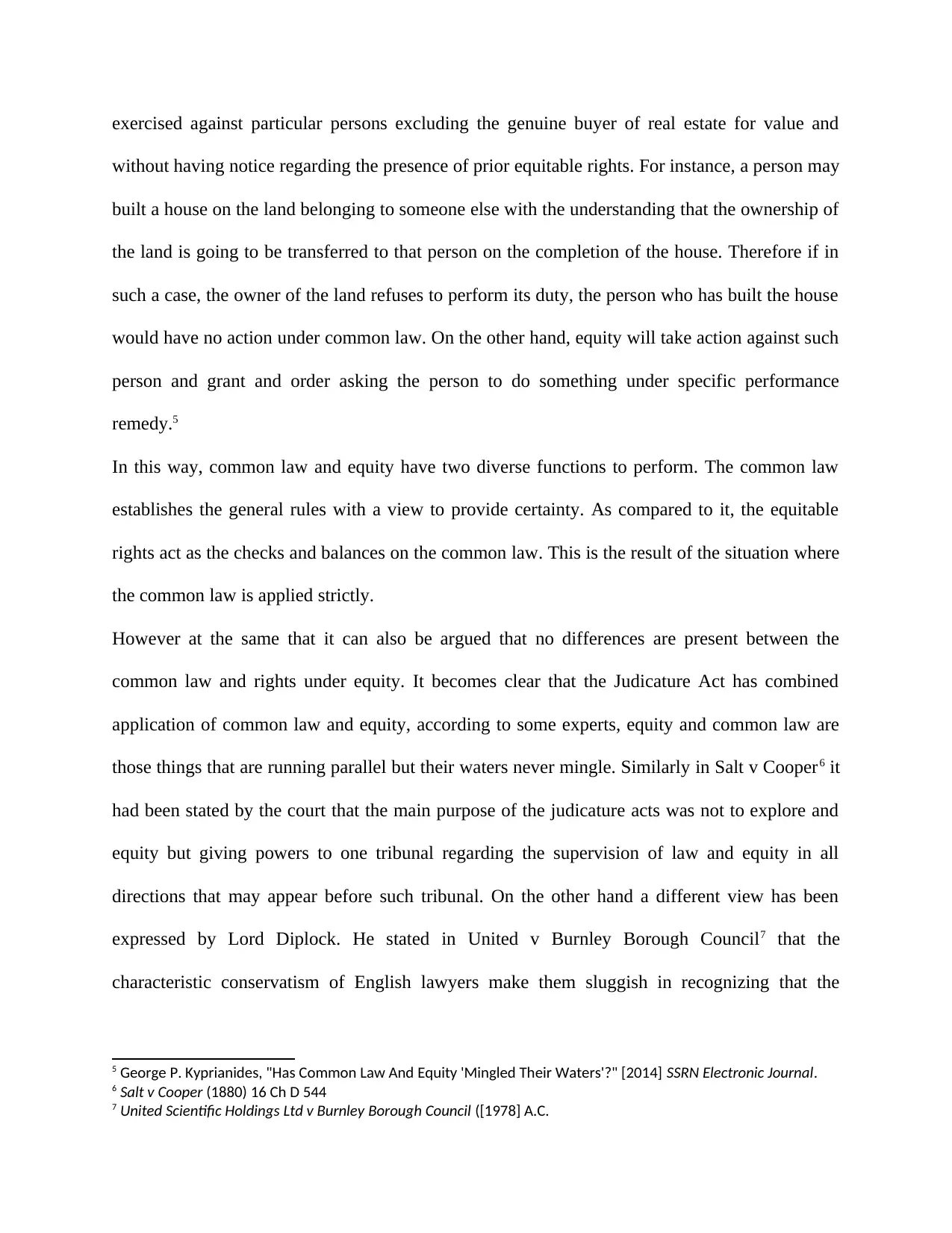
exercised against particular persons excluding the genuine buyer of real estate for value and
without having notice regarding the presence of prior equitable rights. For instance, a person may
built a house on the land belonging to someone else with the understanding that the ownership of
the land is going to be transferred to that person on the completion of the house. Therefore if in
such a case, the owner of the land refuses to perform its duty, the person who has built the house
would have no action under common law. On the other hand, equity will take action against such
person and grant and order asking the person to do something under specific performance
remedy.5
In this way, common law and equity have two diverse functions to perform. The common law
establishes the general rules with a view to provide certainty. As compared to it, the equitable
rights act as the checks and balances on the common law. This is the result of the situation where
the common law is applied strictly.
However at the same that it can also be argued that no differences are present between the
common law and rights under equity. It becomes clear that the Judicature Act has combined
application of common law and equity, according to some experts, equity and common law are
those things that are running parallel but their waters never mingle. Similarly in Salt v Cooper6 it
had been stated by the court that the main purpose of the judicature acts was not to explore and
equity but giving powers to one tribunal regarding the supervision of law and equity in all
directions that may appear before such tribunal. On the other hand a different view has been
expressed by Lord Diplock. He stated in United v Burnley Borough Council7 that the
characteristic conservatism of English lawyers make them sluggish in recognizing that the
5 George P. Kyprianides, "Has Common Law And Equity 'Mingled Their Waters'?" [2014] SSRN Electronic Journal.
6 Salt v Cooper (1880) 16 Ch D 544
7 United Scientific Holdings Ltd v Burnley Borough Council ([1978] A.C.
without having notice regarding the presence of prior equitable rights. For instance, a person may
built a house on the land belonging to someone else with the understanding that the ownership of
the land is going to be transferred to that person on the completion of the house. Therefore if in
such a case, the owner of the land refuses to perform its duty, the person who has built the house
would have no action under common law. On the other hand, equity will take action against such
person and grant and order asking the person to do something under specific performance
remedy.5
In this way, common law and equity have two diverse functions to perform. The common law
establishes the general rules with a view to provide certainty. As compared to it, the equitable
rights act as the checks and balances on the common law. This is the result of the situation where
the common law is applied strictly.
However at the same that it can also be argued that no differences are present between the
common law and rights under equity. It becomes clear that the Judicature Act has combined
application of common law and equity, according to some experts, equity and common law are
those things that are running parallel but their waters never mingle. Similarly in Salt v Cooper6 it
had been stated by the court that the main purpose of the judicature acts was not to explore and
equity but giving powers to one tribunal regarding the supervision of law and equity in all
directions that may appear before such tribunal. On the other hand a different view has been
expressed by Lord Diplock. He stated in United v Burnley Borough Council7 that the
characteristic conservatism of English lawyers make them sluggish in recognizing that the
5 George P. Kyprianides, "Has Common Law And Equity 'Mingled Their Waters'?" [2014] SSRN Electronic Journal.
6 Salt v Cooper (1880) 16 Ch D 544
7 United Scientific Holdings Ltd v Burnley Borough Council ([1978] A.C.
Paraphrase This Document
Need a fresh take? Get an instant paraphrase of this document with our AI Paraphraser

Judicature Act 1873, the two systems of substantial and adjective law, which were earlier,
managed by a court of law and equity have been combined.
Common law had established itself as a self-sufficient legal system or an independent source of
law when it is equated with equity. It becomes particularly clear when we see the fact that the
presence of common law is assumed by equity. Consequently if equity system is eliminated, still
there will be a coherent legal system, but this is not the case with common law. Therefore, equity
has been established as a step for dealing with the inflexibility present in case of common law.
Consequently during the early years, equity was mainly considered as being against the common
law. Most of the people in the legal circles were of the opinion that as a result of the inception of
equity, and the common law legal system is going to be abrogated. However, the available
evidence suggests that the model development of equity has not abrogated the, now, but instead
it had played a role in strengthening common law system.8
It is also provided by the law that whenever there is a clash among the rules of these legal
systems, equitable rules are going to overcome, as compared to common law. The general
influence of the Judicature Act had merged the two legal systems was that the separate and
exclusive jurisdiction of equity has been converted into a simultaneous authority. The result was
that there was no longer any need for going to a separate court if a party for the two obtained an
equitable remedy. The change was not only applicable in case of the United Kingdom, but it was
applicable in all Commonwealth nations including Australia. However, the legal system of
equity continues to perform the basic function assigned to it. This function is to supplement and
compliment the, according to the morally acceptable notions of justice and fairness.
8 David RR Parker, "The 2012 Metamorphosis Of The Common Law Of Compulsory Acquisition Valuation In
Australia" (2015) 44(3) Common Law World Review
managed by a court of law and equity have been combined.
Common law had established itself as a self-sufficient legal system or an independent source of
law when it is equated with equity. It becomes particularly clear when we see the fact that the
presence of common law is assumed by equity. Consequently if equity system is eliminated, still
there will be a coherent legal system, but this is not the case with common law. Therefore, equity
has been established as a step for dealing with the inflexibility present in case of common law.
Consequently during the early years, equity was mainly considered as being against the common
law. Most of the people in the legal circles were of the opinion that as a result of the inception of
equity, and the common law legal system is going to be abrogated. However, the available
evidence suggests that the model development of equity has not abrogated the, now, but instead
it had played a role in strengthening common law system.8
It is also provided by the law that whenever there is a clash among the rules of these legal
systems, equitable rules are going to overcome, as compared to common law. The general
influence of the Judicature Act had merged the two legal systems was that the separate and
exclusive jurisdiction of equity has been converted into a simultaneous authority. The result was
that there was no longer any need for going to a separate court if a party for the two obtained an
equitable remedy. The change was not only applicable in case of the United Kingdom, but it was
applicable in all Commonwealth nations including Australia. However, the legal system of
equity continues to perform the basic function assigned to it. This function is to supplement and
compliment the, according to the morally acceptable notions of justice and fairness.
8 David RR Parker, "The 2012 Metamorphosis Of The Common Law Of Compulsory Acquisition Valuation In
Australia" (2015) 44(3) Common Law World Review
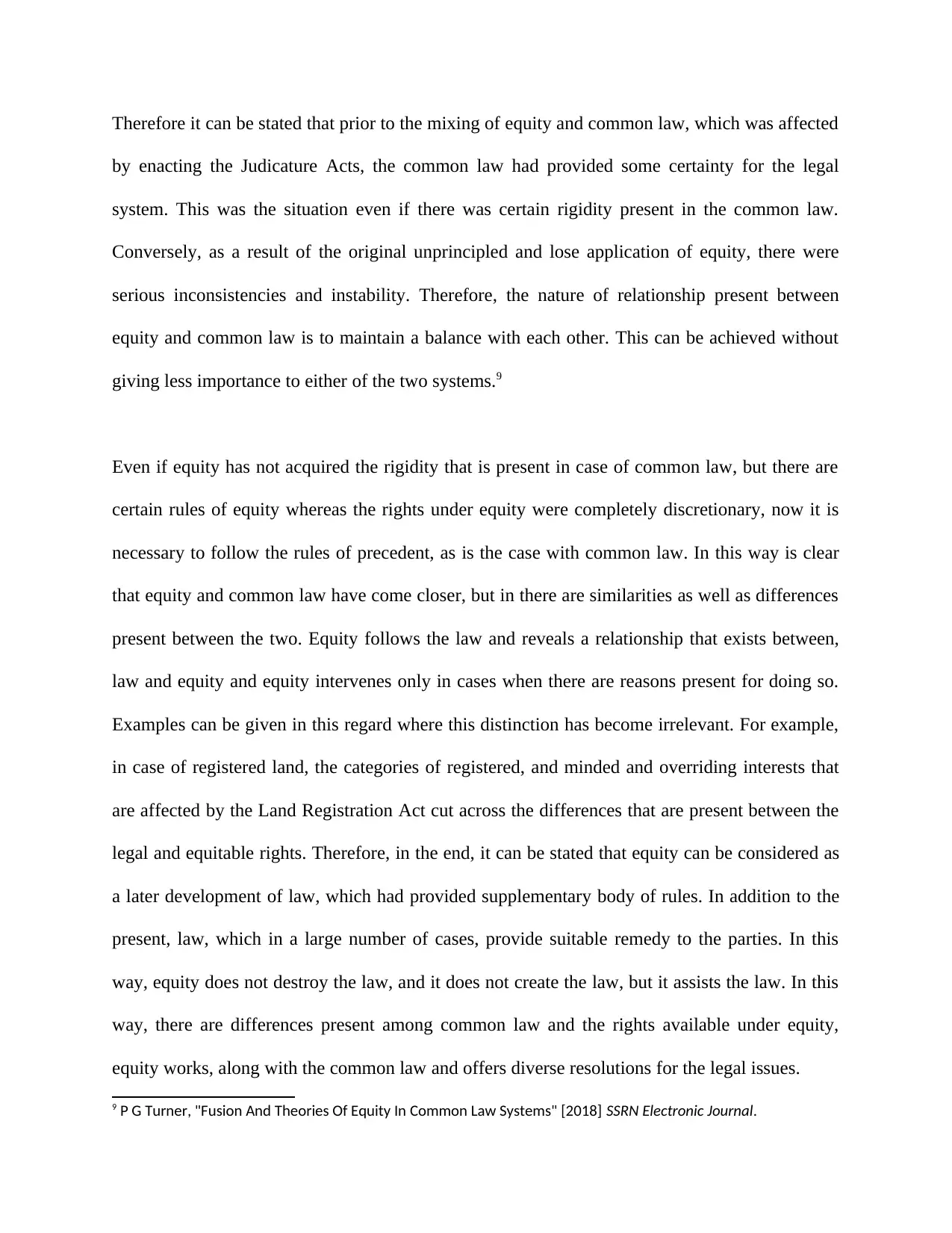
Therefore it can be stated that prior to the mixing of equity and common law, which was affected
by enacting the Judicature Acts, the common law had provided some certainty for the legal
system. This was the situation even if there was certain rigidity present in the common law.
Conversely, as a result of the original unprincipled and lose application of equity, there were
serious inconsistencies and instability. Therefore, the nature of relationship present between
equity and common law is to maintain a balance with each other. This can be achieved without
giving less importance to either of the two systems.9
Even if equity has not acquired the rigidity that is present in case of common law, but there are
certain rules of equity whereas the rights under equity were completely discretionary, now it is
necessary to follow the rules of precedent, as is the case with common law. In this way is clear
that equity and common law have come closer, but in there are similarities as well as differences
present between the two. Equity follows the law and reveals a relationship that exists between,
law and equity and equity intervenes only in cases when there are reasons present for doing so.
Examples can be given in this regard where this distinction has become irrelevant. For example,
in case of registered land, the categories of registered, and minded and overriding interests that
are affected by the Land Registration Act cut across the differences that are present between the
legal and equitable rights. Therefore, in the end, it can be stated that equity can be considered as
a later development of law, which had provided supplementary body of rules. In addition to the
present, law, which in a large number of cases, provide suitable remedy to the parties. In this
way, equity does not destroy the law, and it does not create the law, but it assists the law. In this
way, there are differences present among common law and the rights available under equity,
equity works, along with the common law and offers diverse resolutions for the legal issues.
9 P G Turner, "Fusion And Theories Of Equity In Common Law Systems" [2018] SSRN Electronic Journal.
by enacting the Judicature Acts, the common law had provided some certainty for the legal
system. This was the situation even if there was certain rigidity present in the common law.
Conversely, as a result of the original unprincipled and lose application of equity, there were
serious inconsistencies and instability. Therefore, the nature of relationship present between
equity and common law is to maintain a balance with each other. This can be achieved without
giving less importance to either of the two systems.9
Even if equity has not acquired the rigidity that is present in case of common law, but there are
certain rules of equity whereas the rights under equity were completely discretionary, now it is
necessary to follow the rules of precedent, as is the case with common law. In this way is clear
that equity and common law have come closer, but in there are similarities as well as differences
present between the two. Equity follows the law and reveals a relationship that exists between,
law and equity and equity intervenes only in cases when there are reasons present for doing so.
Examples can be given in this regard where this distinction has become irrelevant. For example,
in case of registered land, the categories of registered, and minded and overriding interests that
are affected by the Land Registration Act cut across the differences that are present between the
legal and equitable rights. Therefore, in the end, it can be stated that equity can be considered as
a later development of law, which had provided supplementary body of rules. In addition to the
present, law, which in a large number of cases, provide suitable remedy to the parties. In this
way, equity does not destroy the law, and it does not create the law, but it assists the law. In this
way, there are differences present among common law and the rights available under equity,
equity works, along with the common law and offers diverse resolutions for the legal issues.
9 P G Turner, "Fusion And Theories Of Equity In Common Law Systems" [2018] SSRN Electronic Journal.
⊘ This is a preview!⊘
Do you want full access?
Subscribe today to unlock all pages.

Trusted by 1+ million students worldwide

Paraphrase This Document
Need a fresh take? Get an instant paraphrase of this document with our AI Paraphraser
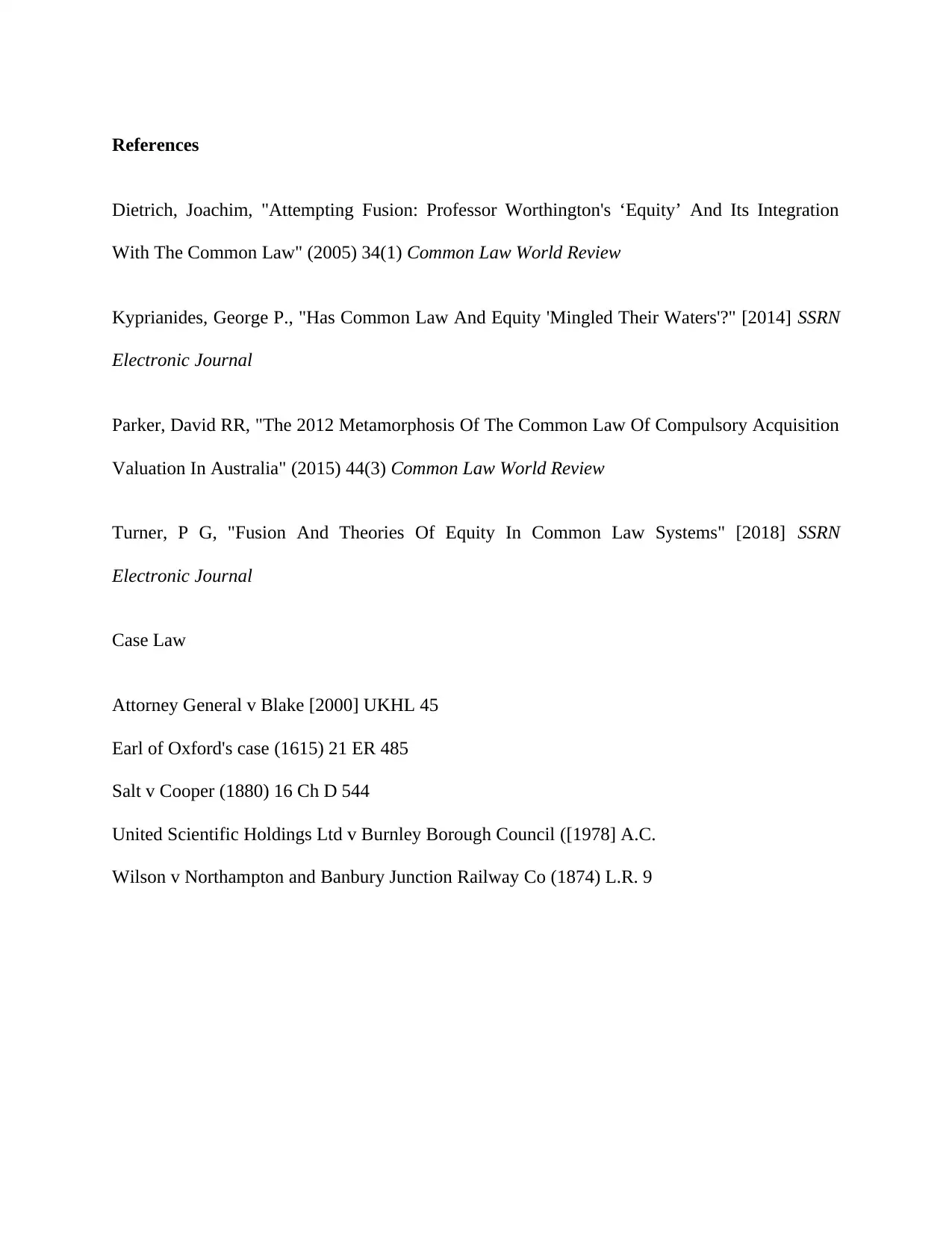
References
Dietrich, Joachim, "Attempting Fusion: Professor Worthington's ‘Equity’ And Its Integration
With The Common Law" (2005) 34(1) Common Law World Review
Kyprianides, George P., "Has Common Law And Equity 'Mingled Their Waters'?" [2014] SSRN
Electronic Journal
Parker, David RR, "The 2012 Metamorphosis Of The Common Law Of Compulsory Acquisition
Valuation In Australia" (2015) 44(3) Common Law World Review
Turner, P G, "Fusion And Theories Of Equity In Common Law Systems" [2018] SSRN
Electronic Journal
Case Law
Attorney General v Blake [2000] UKHL 45
Earl of Oxford's case (1615) 21 ER 485
Salt v Cooper (1880) 16 Ch D 544
United Scientific Holdings Ltd v Burnley Borough Council ([1978] A.C.
Wilson v Northampton and Banbury Junction Railway Co (1874) L.R. 9
Dietrich, Joachim, "Attempting Fusion: Professor Worthington's ‘Equity’ And Its Integration
With The Common Law" (2005) 34(1) Common Law World Review
Kyprianides, George P., "Has Common Law And Equity 'Mingled Their Waters'?" [2014] SSRN
Electronic Journal
Parker, David RR, "The 2012 Metamorphosis Of The Common Law Of Compulsory Acquisition
Valuation In Australia" (2015) 44(3) Common Law World Review
Turner, P G, "Fusion And Theories Of Equity In Common Law Systems" [2018] SSRN
Electronic Journal
Case Law
Attorney General v Blake [2000] UKHL 45
Earl of Oxford's case (1615) 21 ER 485
Salt v Cooper (1880) 16 Ch D 544
United Scientific Holdings Ltd v Burnley Borough Council ([1978] A.C.
Wilson v Northampton and Banbury Junction Railway Co (1874) L.R. 9
1 out of 8
Related Documents
Your All-in-One AI-Powered Toolkit for Academic Success.
+13062052269
info@desklib.com
Available 24*7 on WhatsApp / Email
![[object Object]](/_next/static/media/star-bottom.7253800d.svg)
Unlock your academic potential
Copyright © 2020–2025 A2Z Services. All Rights Reserved. Developed and managed by ZUCOL.




